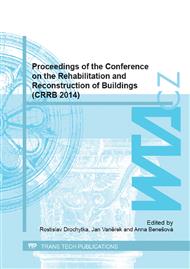p.3
p.7
p.11
p.15
p.19
p.23
p.31
p.35
Application of Colored Impregnating Glazes on Wood and Color Changes due to Artificial Aging
Abstract:
Wood as organic material is extremely stressed and it is surface may be damaged over time due to atmospheric effects, mainly due to solar radiation and exposure to water. The purpose of this experiment is to compare colour changes of selected impregnation stain the wood, which in practice is primarily used for facade systems. These are among some of the most stressed parts of the building and construction, they must be paid great attention. Wood samples were painted with a colour glaze impregnation and subsequently subjected to artificial aging. The results show that the type of selected species, but also finish before applying a waterproofing glaze can affect subsequent changes light fastness whether, it is a lightening or darkening.
Info:
Periodical:
Pages:
3-6
Citation:
Online since:
August 2015
Authors:
Keywords:
Price:
Сopyright:
© 2015 Trans Tech Publications Ltd. All Rights Reserved
Share:
Citation:


